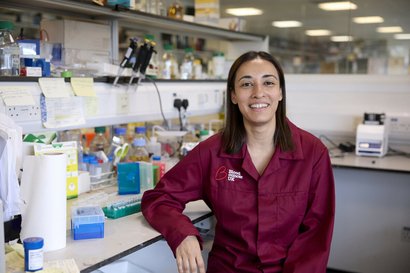Treatment for mantle cell lymphoma
Treatment aims to get rid of as much lymphoma as possible to give you the longest period of remission.
Deciding your treatment plan
The treatment you have will depend on several things. A team of specialists (called the MDT or multidisciplinary team) work together to agree what treatment plan will be most effective for you, considering:
- the type of lymphoma you have and whether it is low grade (growing slowly) or high grade (growing quickly)
- the stage of the lymphoma and where it is in your body
- any symptoms you have
- your age, fitness and general health
- possible clinical trials that are available
Some teams may also work out your prognostic score, which helps to gauge your level of risk and what’s likely to happen after treatment.
The mantle cell prognostic index (MIPI) is the one most often used in the UK. It works by counting points based on your age, your ability to perform daily activities, your white blood cell count, and your lactate dehydrogenase (LDH) count. LDH is a protein that’s often at a high level when you have lymphoma.
The final total score puts you in a low-risk, intermediate-risk or high-risk group. This is used to help plan the most effective treatment for you, while trying to avoid unnecessary side effects.
Below are the most commonly used treatment plans in mantle cell lymphoma.
How you are feeling
Getting diagnosed can feel overwhelming and it might take a while to understand your condition. Take your time to process the information, and when you are ready, your team will be there to support you with any questions you might have about treatment.
You can also contact our Support Service on 0808 2080 888 or [email protected]. Calls are free.
Active monitoring (watch and wait)
If you are diagnosed with a low grade form of mantle cell lymphoma (usually the leukaemic non-nodal type), treatment might not be needed straight away. Instead you will go on active monitoring, also known as watch and wait.
For many conditions that develop slowly, there is no evidence that having treatment earlier will improve the outcome. Saving treatment for later when symptoms get worse is thought to be the best approach.
If you are on active monitoring, you will have regular tests to check if and how the lymphoma is progressing. If you start to show symptoms, your team may decide to start you on treatment.
Some people can be on active monitoring for months or years. During this time, doctors may give you advice on keeping well, such as ways you can reduce your risk of infection and keep healthy, active, and strong.
It can be challenging to live with the uncertainty and emotional impact of active monitoring. Many people find it helpful to connect with others in a similar position through our online community forum, where you can find conversations specifically about being on active monitoring (watch and wait).
The living with mantle cell lymphoma section of this information also provides tips on how you can cope both physically and emotionally, including when you are on active monitoring.
Radiotherapy
If mantle cell lymphoma is diagnosed at an early stage (1 or 2), you may have radiotherapy to remove as much of the lymphoma as possible.
Radiotherapy uses high-energy rays, such as X-rays, to destroy cancer cells. Radiotherapy involves going into hospital and lying in a radiotherapy machine, where high energy rays will be aimed at the region where the mantle cell lymphoma is. You don’t normally feel anything. Your treatment team will tell you how long and how often you should expect to have radiotherapy for.
Radiotherapy can be very effective at removing lymphoma that is limited to one or a few specific areas of the body. However, after some time, it is common for the lymphoma to come back and require further treatment.
For those with more advanced mantle cell lymphoma (stage 3 or 4), the lymphoma is likely to be widespread, so doctors usually use treatments that work in multiple regions of the body, such as chemotherapy and immunotherapy. Radiotherapy can sometimes be used alongside these treatments to reduce the size of specific swellings or to reduce pain.
Chemo-immunotherapy
A combination of chemotherapy and immunotherapy – known as chemo-immunotherapy – is usually the first treatment for those with advanced mantle cell lymphoma.
- Chemotherapy uses cancer killing drugs (cytotoxic drugs) to destroy cancer cells. There are many different chemotherapy drugs.
- Immunotherapy drugs work with your own immune system to detect and destroy cancer cells. Some immunotherapy drugs are known as targeted therapy because they specifically target cancer cells.
Rituximab
In mantle cell lymphoma, a targeted immunotherapy drug called rituximab is often used. Rituximab sticks to specific proteins found on the surface of lymphocytes. This blocks the lymphocytes from being able to grow and multiply, and “tags” them, making it easier for the immune system to find and destroy them. Rituximab is usually combined with chemotherapy.
Drug options
Different combinations of chemotherapy and immunotherapy, as well as some steroids, can be used in mantle cell lymphoma. Your team will decide which drugs to use based on your individual circumstances.
Treatments for mantle cell lymphoma include intensive and less intensive combinations.
Intensive chemo-immunotherapy treatments
You may have an intensive chemoimmunotherapy treatment plan that includes a high dose of a chemotherapy drug called cytarabine.
Intensive treatments offer the best chance of putting you into remission (where they are no or very few cancer cells left), but they usually cause side effects. So they can only be used if your team believe you are fit enough to cope with the treatment and side effects.
Combines rituximab immunotherapy with chemotherapy drugs cyclophosphamide, doxorubicin, vincristine, cytarabine, and the steroid prednisolone. Also known as the Nordic protocol.
Combines rituximab immunotherapy with chemotherapy drugs cytarabine and cisplatin, and dexamethasone, a steroid.
Combines rituximab immunotherapy with chemotherapy drugs cyclophosphamide, doxorubicin and vincristine, and the steroid prednisolone
Combines rituximab immunotherapy with chemotherapy drugs cyclophosphamide, doxorubicin, the steroid prednisolone and a targeted drug called bortezomib (Velcade)
Rituximab immunotherapy combined with the chemotherapy drug bendamustine.
Rituximab combined with two chemotherapy drugs, bendamustine and cytarabine.
Less intensive chemo-immunotherapy treatments
If you are not well enough for intensive treatment, doctors may recommend a less intensive treatment. The aim of these treatments is still to put you in remission, or to control the mantle cell lymphoma and give you a good quality of life.
Rituximab immunotherapy combined with the chemotherapy drug chlorambucil.
Combines rituximab immunotherapy with chemotherapy drugs cyclophosphamide and vincristine, and the steroid prednisolone.
Read about others' experiences of blood cancer
People find it helps to hear how other people learn to live with a blood cancer diagnosis and what helps them get through it.
Read our blood cancer stories.

How is chemo-immunotherapy given?
Chemo-immunotherapy drugs can be given through a drip into your vein (intravenous or IV drip), by tablet, or by injection, depending on the drug.
It can take a few hours to have your treatment, particularly at first. Rituximab has to be given very slowly through a drip as some people react badly if it is infused too quickly. You will be given antihistamine to help stop a reaction.
Many courses of treatment can be given in a chemotherapy day unit at your hospital, so you can go home in between treatment sessions. For some treatments, you will need to stay in hospital for a period of time.
Ask your hospital team what to expect and how long treatment is likely to last.
Treatment with TKIs (inhibitors)
Tyrosine kinase inhibitors (TKIs) are targeted treatments that work by stopping (inhibiting) cancer cells dividing and growing. They are taken as a daily tablet at home and tend to cause fewer side effects than chemotherapy.
At the moment, they are only an option for people with mantle cell lymphoma if the first treatment doesn’t work well enough to control the lymphoma. With more research and clinical trials happening, they may be available in other situations in the future,
Maintenance treatment
Treatment aims to put you into remission, where there are no or very few cancer cells left in your body. As mantle cell lymphoma usually comes back (relapses), your doctor will consider if you are likely to benefit from more treatment after the first chemo-immunotherapy, to keep you in remission as long as possible. This is called maintenance treatment.
If standard or less intense chemoimmunotherapy puts you in remission, you may have maintenance therapy afterwards. This involves having injections of rituximab every other month for two years. Maintenance therapy helps to keep mantle cell lymphoma under control.
If you had a more intensive treatment containing cytarabine, you are likely to have a stem cell transplant afterwards to further increase the chance of a long-lasting remission. You will then also have maintenance therapy, which involves injections of rituximab every other month for two years.
Stem cell transplant
Having a stem cell transplant after intensive chemoimmunotherapy with cytarabine gives the best chance of having a long remission. You may be offered a stem cell transplant if you go into complete remission after a course of chemotherapy.
In mantle cell lymphoma, autologous or auto stem cell transplants are used – this means the transplant uses your own healthy cells rather than cells from a donor.
An auto stem cell transplant uses your own stem cells (the earliest form of blood cells, which grow in your bone marrow) to replace the stem cells that have been destroyed during treatment.
Your healthy stem cells are collected (harvested) and frozen after an initial course of chemotherapy. When the time comes for your transplant, you will need to stay in hospital for more chemotherapy. A few days later your thawed stem cells will be put back into your body (transplanted). You will be closely monitored by your hospital team for the next few weeks.
After the transplant, you will have maintenance therapy with rituximab to keep you in remission for as long as possible.
To have an auto stem cell transplant, you must be fit enough to cope with the intensive chemotherapy, as well the risks of transplant.
We have more a free booklet about about having a stem cell transplant.
Research and clinical trials
Experts are continuing to research mantle cell lymphoma and other rare types of blood cancer to learn more about the best way to treat them. Carefully designed clinical trials are an important part of finding new treatments for blood cancers.
Several treatments are currently being looked at for lymphomas, including mantle cell lymphoma. These include tyrosine kinase inhibitors (TKIs) and new antibody treatments.
You might have the opportunity to take part in a clinical trial, contributing to research and giving you the chance of a new treatment that may not be available otherwise. Ask your hospital team if there are any relevant clinical trials you could join.
If you want to learn more about the clinical trials available to you or have any questions about being involved in a clinical trial, visit our Clinical Trials Information Hub or get in touch with our Clinical Trials Support Service.

Our research
Our £500 million investment in research since 1960 has helped transform treatments and taken us to the point where beating blood cancer is now in sight. Our researchers are working to finish the job.
More About This